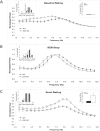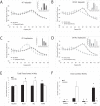Persistent hyperdopaminergia decreases the peak frequency of hippocampal theta oscillations during quiet waking and REM sleep
- PMID: 19381303
- PMCID: PMC2668764
- DOI: 10.1371/journal.pone.0005238
Persistent hyperdopaminergia decreases the peak frequency of hippocampal theta oscillations during quiet waking and REM sleep
Abstract
Long-term changes in dopaminergic signaling are thought to underlie the pathophysiology of a number of psychiatric disorders. Several conditions are associated with cognitive deficits such as disturbances in attention processes and learning and memory, suggesting that persistent changes in dopaminergic signaling may alter neural mechanisms underlying these processes. Dopamine transporter knockout (DAT-KO) mice exhibit a persistent five-fold increase in extracellular dopamine levels. Here, we demonstrate that DAT-KO mice display lower hippocampal theta oscillation frequencies during baseline periods of waking and rapid-eye movement sleep. These altered theta oscillations are not reversed via treatment with the antidopaminergic agent haloperidol. Thus, we propose that persistent hyperdopaminergia, together with secondary alterations in other neuromodulatory systems, results in lower frequency activity in neural systems responsible for various cognitive processes.
Conflict of interest statement
Figures


Similar articles
-
Parallel loss of hippocampal LTD and cognitive flexibility in a genetic model of hyperdopaminergia.Neuropsychopharmacology. 2007 Oct;32(10):2108-16. doi: 10.1038/sj.npp.1301354. Epub 2007 Mar 7. Neuropsychopharmacology. 2007. PMID: 17342172 Free PMC article.
-
Hyperdopaminergia and NMDA receptor hypofunction disrupt neural phase signaling.J Neurosci. 2009 Jun 24;29(25):8215-24. doi: 10.1523/JNEUROSCI.1773-09.2009. J Neurosci. 2009. PMID: 19553461 Free PMC article.
-
Dopaminergic control of sleep-wake states.J Neurosci. 2006 Oct 11;26(41):10577-89. doi: 10.1523/JNEUROSCI.1767-06.2006. J Neurosci. 2006. PMID: 17035544 Free PMC article.
-
[Behavioral and pharmacological characteristics of mice lacking the dopamine transporter].Postepy Hig Med Dosw (Online). 2004;58:560-4. Postepy Hig Med Dosw (Online). 2004. PMID: 15765018 Review. Polish.
-
Brainstem system of hippocampal theta induction: The role of the ventral tegmental area.Synapse. 2015 Nov;69(11):553-75. doi: 10.1002/syn.21843. Epub 2015 Aug 19. Synapse. 2015. PMID: 26234671 Review.
Cited by
-
Chronic in vivo multi-circuit neurophysiological recordings in mice.J Neurosci Methods. 2011 Jan 30;195(1):36-46. doi: 10.1016/j.jneumeth.2010.11.014. Epub 2010 Nov 27. J Neurosci Methods. 2011. PMID: 21115042 Free PMC article.
-
Genetic loss of the dopamine transporter significantly impacts behavioral and molecular responses to sub-chronic stress in mice.Front Mol Neurosci. 2024 Feb 29;17:1315366. doi: 10.3389/fnmol.2024.1315366. eCollection 2024. Front Mol Neurosci. 2024. PMID: 38486964 Free PMC article.
-
Differential Modulation of Dopamine D2 Receptor on Somatostatin and Parvalbumin Interneurons in the CA1 Area of the Dorsal Hippocampus.Eur J Neurosci. 2025 Jul;62(1):e70176. doi: 10.1111/ejn.70176. Eur J Neurosci. 2025. PMID: 40653805 Free PMC article.
-
Penetrating Ballistic Brain Injury Produces Acute Alterations in Sleep and Circadian-Related Genes in the Rodent Cortex: A Preliminary Study.Front Neurol. 2021 Oct 21;12:745330. doi: 10.3389/fneur.2021.745330. eCollection 2021. Front Neurol. 2021. PMID: 34777213 Free PMC article.
-
Trace Amine-Associated Receptor 1 Regulates Wakefulness and EEG Spectral Composition.Neuropsychopharmacology. 2017 May;42(6):1305-1314. doi: 10.1038/npp.2016.216. Epub 2016 Sep 23. Neuropsychopharmacology. 2017. PMID: 27658486 Free PMC article.
References
-
- Timo-Iaria C, Negrao N, Schmidek WR, Hoshino K, Lobato de Menezes CE, et al. Phases and states of sleep in the rat. Physiol Behav. 1970;5:1057–1062. - PubMed
-
- Buzsaki G. Theta oscillations in the hippocampus. Neuron. 2002;33:325–340. - PubMed
-
- Jouvet M. Biogenic amines and the states of sleep. Science. 1969;163:32–41. - PubMed
-
- Siapas AG, Lubenov EV, Wilson MA. Prefrontal phase locking to hippocampal theta oscillations. Neuron. 2005;46:141–151. - PubMed
-
- Seidenbecher T, Laxmi TR, Stork O, Pape HC. Amygdalar and hippocampal theta rhythm synchronization during fear memory retrieval. Science. 2003;301:846–850. - PubMed
Publication types
MeSH terms
Substances
Grants and funding
LinkOut - more resources
Full Text Sources
Molecular Biology Databases
Research Materials

